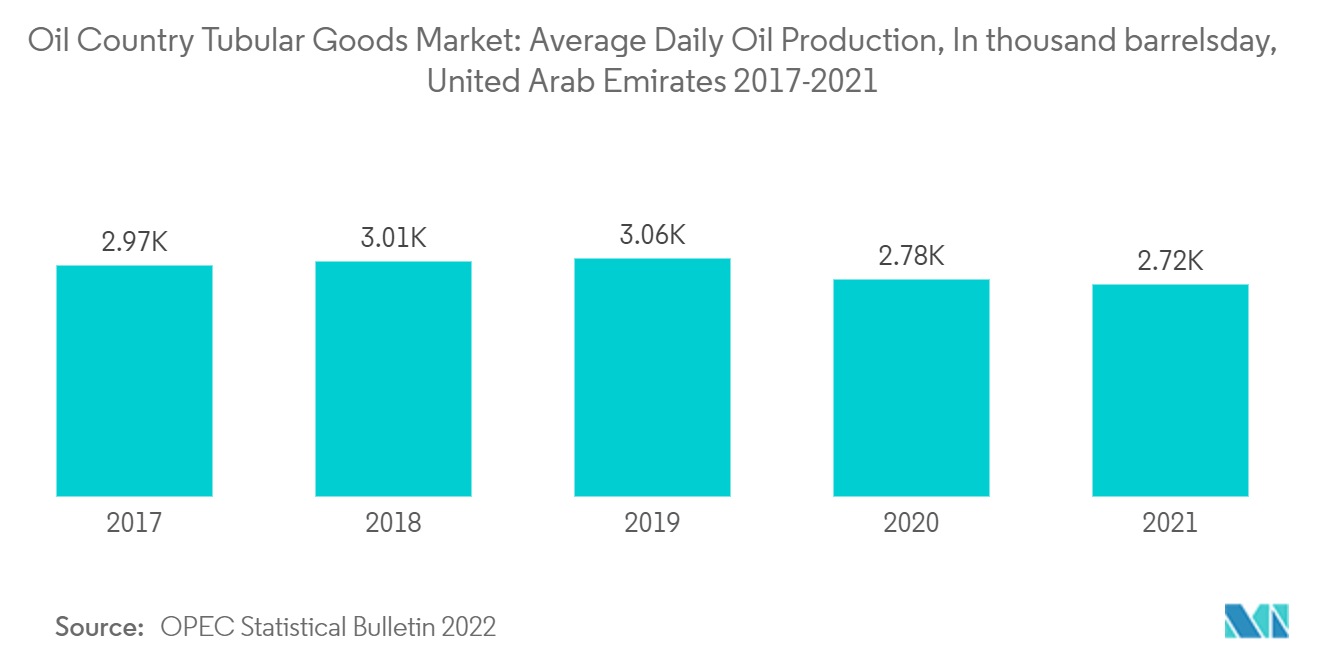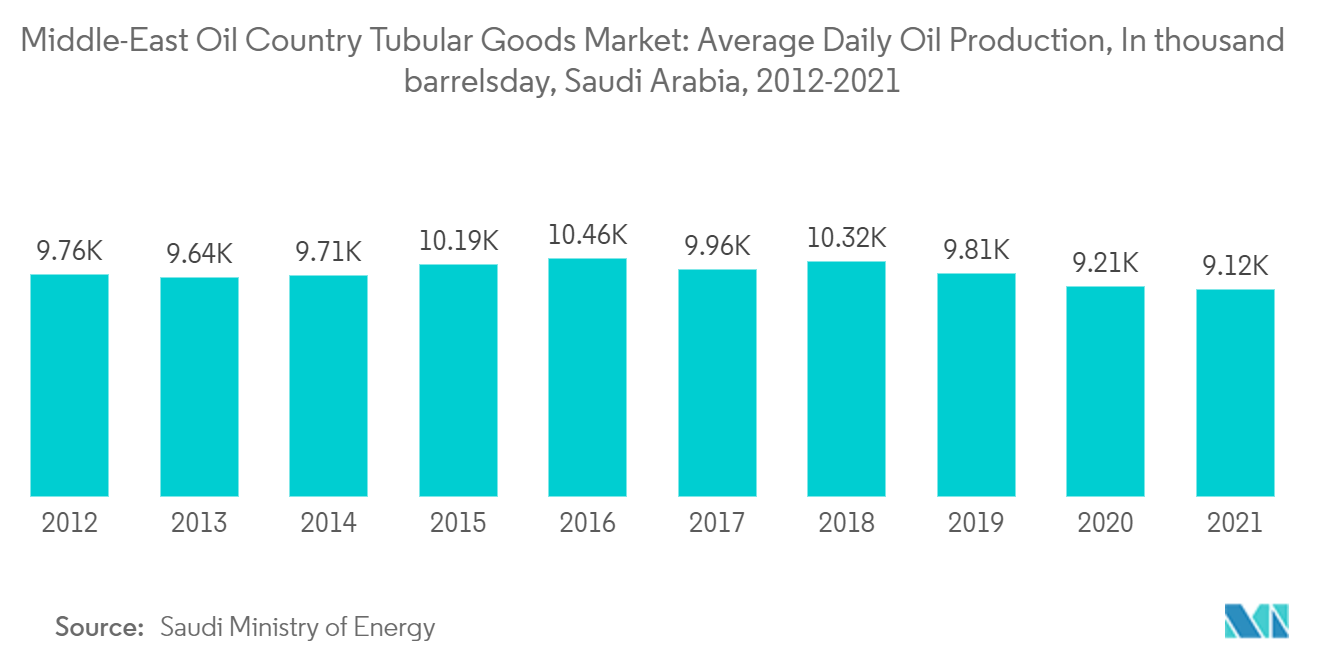Market Trends of Middle-East Oil Country Tubular Goods (OCTG) Industry
This section covers the major market trends shaping the Middle-East Oil Country Tubular Goods Market according to our research experts:
Premium-grade OCTG to Witness Significant Growth
- The premium-grade OCTG market is in a growing phase on account of increasing demand from upstream activities. The premium-grade applications are widespread in gas wells and high-pressure and temperature wells.
- The exploration of natural gas is receiving huge impetus with a surge in the development of shale reserves. Horizontal directional drilling has promulgated the production of natural gas from shale reserves, giving a big boost to the premium-grade OCTG market in the Middle East.
- The United Arab Emirates (UAE) is the fourth-largest crude oil producer in the Middle East & North African region. According to OPEC statistics, the country produced an average of 2,718 thousand barrels/day of oil in 2021. According to OPEC Annual Statistical Bulletin 2022, the country also produced 54.49 billion cubic meters (Bcm) of natural gas in 2021.
- Like its GCC neighbors, the country's economy is heavily dependent on energy exports as the primary source of foreign revenue. As of 2021, according to OPEC Annual Statistical Bulletin 2022, proved natural gas reserves stood at 8.2 trillion cubic metres, while proven oil reserves stood at 111 billion barrels.
- About 90% of the total reserves are in Abu Dhabi, followed by Dubai, Sharjah, and Ras al-Khaimah. The Umm Shaif, Bu Hasa, Upper Zakum and Lower Zakum, and Habshun are the largest oilfields in Abu Dhabi, while Dubai has the Fateh, Rashid and Faleh fields. Sharjah, Ras al-Khaimah and Um Al Quwain primarily have gas fields. Most of the acreage, both onshore and offshore, is relatively well explored, while the recent drilling has yielded a few significant discoveries.
- In August 2022, ADNOC offered five framework agreements to major oilfield service companies, which include Al Ghaith Oilfield Supplies and Services Company, Al Mansoori Directional Drilling Services (Al Mansoori), Schlumberger Middle East SA (Schlumberger), Haliburton Worldwide Limited Abu Dhabi (Haliburton), and Weatherford Bin Hamoodah Company LLC (Weatherford). These framework agreements are for directional drilling and logging while drilling (LWD) services for both onshore and offshore assets, and will run for five years, with an option of extending the contracts for two more years.
- Kuwait is one of the major oil and gas producers in the Middle East, which produced nearly 2.71 million barrels per day of crude oil and 12.88 billion standard cubic meters (bscm) of natural gas in 2021. The country held a proven crude oil reserve of around 101.5 billion barrels and 1,784 bscm of natural gas in the same year.
- In March 2022, Kuwait agreed to develop its Durra offshore gas field with Saudi Arabia. The gas field lies in the shared neutral zone between the two nations, and, thus, both nations are eager to develop the area to produce 1 billion cubic feet per day of gas and 84,000 barrels per day of condensate. Both governments are focusing more on natural gas consumption to reduce carbon emissions, thus supporting the nation to export more crude oil to the international market. The Durra gas field project is likely to be jointly developed by Saudi-based Aramco Gulf Operations Company and Kuwait Gulf Oil Company (KGOC). The output would be shared equally by the two countries.
- Countries such as Iran, Iraq, and Egypt have huge reserves of crude oil and natural gas. With the recovery of crude oil prices, the upstream activities in the region are expected to witness growth during the forecast period, which may further increase the demand for premium-grade OCTG.

Saudi Arabia to Drive the Market Demand
- Saudi Arabia is the largest crude oil producer in the Middle East & North African region, and the country has been a global leader in upstream technology. According to the Saudi Ministry of Energy, the country produced 9124.72 thousand barrels/day of crude during 2021, making it the third-largest producer of crude oil. In 2021, the country produced 120.46 billion cubic meters of gas, making it the eighth-largest producer globally.
- The country is the largest producer of crude oil in the Middle East & North African region and has the second-largest proven crude oil reserves globally. The country's E&P sector is dominated by the state-owned hydrocarbon utility Saudi Aramco, the world's largest exporter of crude oil.
- Saudi Arabia's upstream sector is focused on the development of massive limestone reservoirs in the country's onshore and offshore areas, such as the world's largest conventional onshore oil field (Ghawar) and the largest conventional offshore field (Safaniyah). These colossal fields have been producing for a long time and still have significant recoverable reserves. Saudi Arabia has also started the development of the Jafurah Shale play, the country's largest unconventional shale play, estimated to hold nearly 200 trillion cubic feet of shale gas, further boosting the demand for OCTG in the region.
- Drilling and completion of new wells is a significant investment. However, Saudi Arabia has one of the lowest costs of drilling globally. According to Saudi Aramco, the average upstream lifting cost was SAR 11.3 (USD 3) per barrel produced in 2021 and 2020.
- In June 2022, Saudi Aramco awarded a USD 16 million contract for the supply of oil and gas steel pipes to Saudi Steel Pipe Co. In May 2022, Saudi Aramco also awarded Saudi Steel Pipe Co. a USD 26 million contract for the supply of oil and gas steel pipes. Similarly, in January 2022, Saudi Aramco awarded a USD 71 million contract to Arabian Pipes Co. to provide steel pipes. Such developments highlight the dominance of domestic Saudi companies in the supply of low-tech well equipment, which is expected to increase during the forecast period.
- Saudi Arabia has one of the largest hydrocarbon reserves globally, and despite moves made by the government to increase investment in sustainable solutions and renewable energy, the hydrocarbon industry forms the backbone of the economy, and in a high-price environment, the government aims to maximize its profits over the next decade. Saudi Aramco disclosed its plans to boost its capital expenditure (CAPEX) to USD 40-50 billion in 2022, up by nearly 50% from 2021, with further growth expected until 2025.
- The company plans to increase its crude production capacity to 13 million barrels/day by 2027 and aims to increase gas production by nearly 50% by 2030. Such ambitious expansion plans, coupled with new-age goals of complying with sustainability and environmental standards, are expected to attract significant investments and require major innovation in the sector. These factors are expected to drive the upstream market in the country, along with the demand for OCTG, during the forecast period.

